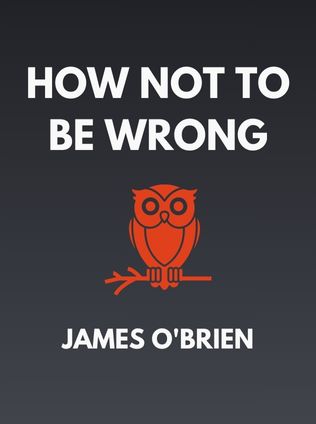
How Not To Be Wrong
The Power of Mathematical Thinking
By James O'Brien
Published 05/2014
About the Author
James O’Brien is a prominent British broadcaster whose voice resonates with millions across the UK. Known for his daily current affairs talk show, which garners over 1.2 million weekly listeners, O’Brien has established himself as a formidable figure in the world of media. His journey, however, is not just about his public persona; it is deeply intertwined with his personal evolution. O’Brien’s rise to prominence was marked by his sharp wit and the almost surgical precision with which he would dismantle the arguments of his guests. His reputation was built on the back of this aggressive style, but in How Not to Be Wrong, O’Brien turns the spotlight inward, using his platform not to dominate, but to question, reflect, and ultimately transform.
O’Brien’s introspective work is a marked departure from the persona he cultivated on air. In this book, he invites readers into a deeply personal exploration of his own beliefs, many of which were shaped by the societal expectations and personal traumas he experienced throughout his life. O’Brien’s journey from a man who prided himself on always being right to one who values understanding and empathy over victory is both inspiring and challenging. It forces readers to consider the cost of clinging to beliefs that, while comforting, may be deeply flawed.
Main Idea
At its core, How Not to Be Wrong is a meditation on the nature of belief and the courage it takes to admit when those beliefs are wrong. O’Brien argues that the inability to admit being wrong is not just a personal failing but a societal one. This refusal often stems from a deeper psychological need to protect oneself from the pain of past experiences. By exploring the roots of his own prejudices and misconceptions, O’Brien makes a compelling case for the importance of self-reflection and the willingness to change. He posits that true strength lies not in the rigidity of one’s convictions but in the ability to adapt, grow, and empathize with others.
O’Brien’s journey is one that many can relate to, as it touches on universal themes of identity, trauma, and the human need for validation. His book is not just a critique of personal beliefs but also a broader commentary on how societal norms and expectations shape our views of ourselves and others. O’Brien’s insights are particularly relevant in today’s polarized world, where the willingness to understand and empathize with those who hold different views is more important than ever.
Table of Contents
- Introduction
- Beliefs About Self
- The Origins of Toxic Masculinity
- Coming to Terms With Childhood Trauma
- Beliefs About Others
- Systemic Inequity and Racism
- Prejudices Against Marginalized Groups
- Conclusion: Empathy as the Key to Change
Beliefs About Self
O’Brien’s exploration of his own beliefs begins with an examination of his sense of self, particularly the notions of toughness and resilience that were instilled in him from a young age. For much of his life, O’Brien subscribed to the belief that pain and adversity were character-building forces, a belief that was reinforced by his experiences in an all-boys boarding school where corporal punishment was the norm.
"The fear and tension that I thought were a part of my identity were actually scars—and they could heal." - James O'Brien
This realization was a pivotal moment for O’Brien, marking the beginning of his journey toward self-awareness. He came to understand that the aggression and confrontational approach that had served him well in his career were not signs of strength but symptoms of deep-seated fear and insecurity. O’Brien’s aggressive demeanor was, in fact, a defense mechanism—a way to protect himself from the vulnerability he feared.
Through therapy, O’Brien began to dismantle the belief that his toughness was a source of strength. He recognized that this belief was rooted in his early experiences of pain and humiliation, experiences that he had never fully processed or understood. Therapy helped him see that his survival personality—the persona he had created to protect himself—was not who he truly was. This persona had been a barrier to forming genuine connections with others, as it kept him constantly on the defensive, ready to fight at the slightest provocation.
Sign up for FREE and get access to 1,400+ books summaries.
You May Also Like
The Subtle Art of Not Giving a F*ck
A Counterintuitive Approach to Living a Good Life
By Mark MansonRich Dad Poor Dad
What the Rich Teach Their Kids About Money - That the Poor and Middle Class Do Not!
By Robert T. KiyosakiHow To Win Friends and Influence People
The All-Time Classic Manual Of People Skills
By Dale CarnegieFreakonomics
A Rogue Economist Explores the Hidden Side of Everything
By Steven D. Levitt and Stephen J. Dubner



















